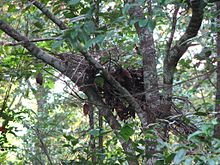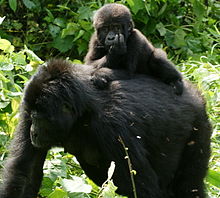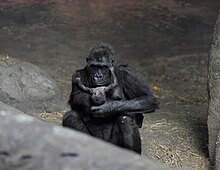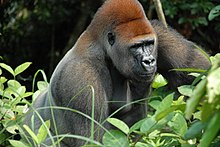ABOUT GORILLAS
http://www.primeugandasafaris.com/gorilla-safaris/4-days-bwindi-gorilla-safari.html
http://www.primeugandasafaris.com/gorilla-safaris/3-days-gorilla-safari-bwindi.html
http://www.primeugandasafaris.com/gorilla-safaris.html
Mountain Gorillas live in groups called troops. These troops are made of one
adult male called the
silverback, multiple adult females and their offspring.However, multiple-male troops also exist in smaller amounts. A silverback is named after the distinctive patch of silver hair on its back which comes with
maturity and is usually more than 12 years of age. Silverbacks also have large canine teeth that also come with
maturity. Both males and females tend to emigrate from their natal
groups. For mountain gorillas, usually females disperse from their natal troops
more than males.Mountain gorillas and western lowland gorillas also commonly transfer to second new groups.Mature males tend to also leave their groups and establish their own
troops by attracting emigrating females. However, male mountain gorillas
sometimes stay in their natal troops and become subordinate to the
silverback. In event of death of a silverback , other males may be able to become
dominant or mate with the females. This behavior has not been observed
in eastern lowland gorillas. In a single male group, when the silverback
dies, the females and their offspring disperse and find a new troop.Without a silverback to protect them, the infants will likely fall victim to infanticide. Joining a new group is likely to be a tactic against this.However, while gorilla troops usually disband after the silverback
dies, but the female eastern lowlands gorillas and their offspring have been
recorded staying together until a new silverback transfers into the
group. This likely serves as protection from leopards.
The silverback is the center of the troop's attention, making all decisions, mediating conflicts,
leading the troop to feeding sites, determining the movements of the group,and taking responsibility for the
safety and well-being of the troop. Younger males known as blackbacks subordinate to the
silverback, , may serve as backup protection.
Blackbacks are aged between 8 and 12 years of age
and lack the silver back hair. The bond a silverback has with his
females forms the core of gorilla social life. Bonds between them are
maintained by grooming and staying close together.Females form strong relationships with males to gain mating
opportunities and protection from predators and infanticidal outside
males.However, aggressive behaviors between males and females do occur, but
rarely lead to serious injury. Relationships between females may vary.
Maternally related females in a troop tend to be friendly towards each
other and associate closely. Otherwise, females have few friendly
encounters and commonly act aggressively towards each other.Females some times fight for social access to males and a male may intervene.Male gorillas have weak social bonds, especially in multiple-male
groups with apparent dominance hierarchies and strong competition for
mates. Males in all-male groups, though, tend to have friendly
interactions and socialize through play, grooming and staying together,and occasionally they even engage in homosexual interactions.
Nesting

Gorilla night nest in a tree.
Gorillas construct nests for daytime and night use. Nests tend to be
simple aggregations of branches and leaves about 2 to 5 ft in diameter and are constructed by individuals. Unlike
chimpanzees or orangutans, Gorillas tend to sleep in nests not on the ground. The
young ones nest with their mothers, but construct nests after three years of
age, initially close to those of their mothers.Gorilla nests are distributed arbitrarily and use of tree species for site and construction appears to be opportunistic.Nest-building by great apes is now considered to be not just animal architecture, but as an important instance
of tool use
.
Reproduction and parenting

Young gorilla riding on mother
Females mature at 10–12 years but can be earlier in captivity; males at 11–13
years. A female’s first ovulatory cycle occurs when she is six years of
age, and is followed by a two-year period of adolescent infertility.The estrous cycle last 30–33 days, with outward ovulation signs subtle
compared to those of chimpanzees. The gestation period lasts 8.5 months.
Female mountain gorillas first give birth at 10 years of age and have
four-year interbirth intervals. Males can be fertile before reaching adulthood. Gorillas mate year round.
When females are on heat, they purse their lips and slowly approach a male while making
eye contact to urge the males to mount her. If the male
does not respond, then she will try to attract his attention by reaching
towards him or slapping the ground.In multiple-male groups, solicitation indicates female preference, but females can be forced to mate with multiple males. By approaching a female and displaying at her or touching her and giving a "train grunt" males incite copulation. Of late, gorillas have been observed engaging in face-to-face sex, a trait once considered unique to humans and bonbons.

Mother gorilla with 10-day old
Gorilla infants are vulnerable and dependant, thus mothers, their primary caregivers, are so important to their survival.Male gorillas are never so active in caring for the young ones, but they play a role in socializing them to other youngsters.The silverback however has a largely supportive relationship with the infants
in his troop and shields them from aggression within the group.Infants remain in contact with their mothers for the first five months and mothers stay near the silverback for protection. Infants suckle at least once per hour and sleep with their mothers in the same nest.
Infants begin to break contact with their mothers after five months,
but only for brief period each time. By 12 months old, infants move up
to five meters from their mothers. At around 18–21 months, the mother and offspring gap increases and they regularly
spend time away from each other.In addition, nursing decreases to once every two hours.Infants spend only half of their time with their mothers by 30 months, they enter their juvenile period at their third year, and this lasts
until their sixth year. At this time, gorillas are weaned and they sleep
in a separate nest from their mothers. After their offspring are weaned, Mature females begin to ovulate and soon become pregnant again.The presence of play partners, including the silverback, minimize conflicts in weaning between mother and offspring.
Lifespan of Gorillas
A gorilla's lives for between 35 and 40 years, although zoo gorillas may live for 50 years and more. Dallas Zoo's Jenny was the oldest ever known gorilla in captivity
until 2008, when she died at the age of 55. Now it is Colo - on December 22, 2011 she celebrated her 55th birthday in Columbus Zoo.
Mode of communication
Gorillas have twenty-five distinct vocalizations recognized, many of which are used primarily for group
communication within dense vegetation. Their sounds classified as grunts and
barks are heard most frequently while traveling, and indicate the
whereabouts of individual group members.They may also be used during social interactions when discipline is
required. Screams and roars signal alarm or warning, and are produced
most often by silverbacks. Deep, rumbling belches suggest contentment
and are heard frequently during feeding and resting periods. They are
the most common form of intragroup communication.Severe aggression
is rare in stable groups, but when two mountain gorilla groups meet,
the two silverbacks can sometimes engage in a fight to death, using
their canines to cause deep, gaping injuries.The entire sequence has nine steps: (i) progressively quickening
hooting, (2) symbolic feeding, (iii) rising bipedally, (iv) throwing
vegetation, (v) chest-beating with cupped hands, (vi) one leg kick, (vii)
sideways running, two-legged to four-legged, (vii) slapping and tearing
vegetation, and (ix) thumping the ground with palms to end display.




Comments
Post a Comment